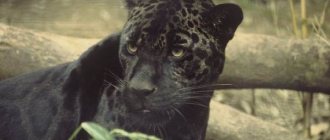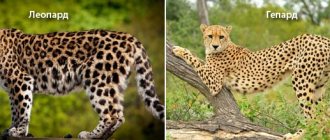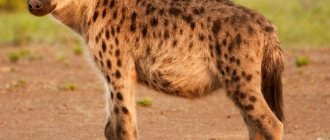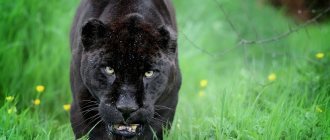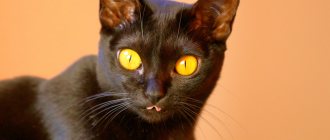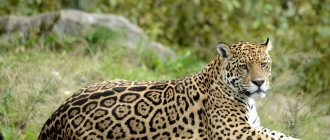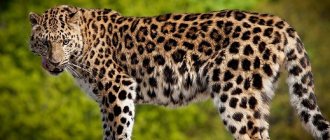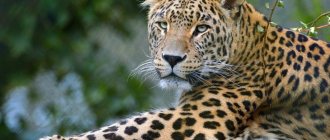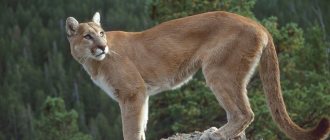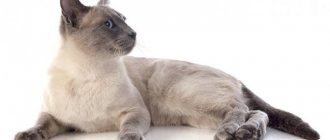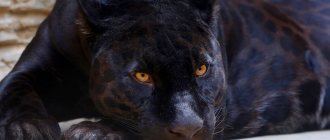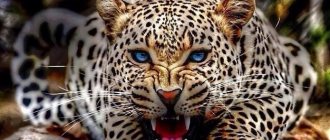There are no more beautiful and graceful animals in the world than representatives of the cat family. In zoos and in natural environments you can see a huge number of beautiful and huge cats, which also include jaguars and panthers.
This American representative of the cat family is very similar in appearance to a leopard, however, at the same time, it is many times greater in size and power. Not every person will be able to distinguish a jaguar from a leopard; they are distinguished from each other by the size of their spots.
A jaguar is a predatory animal belonging to the cat family and the genus panther. On the territory of both Americas, this animal is the only representative belonging to the above-mentioned genus. In the cat family, the jaguar ranks third in size.
This animal is quite difficult to notice in its natural habitat; rather, you can first hear it and only then see it with your own eyes. According to zoologists, the jaguar's voice resembles the sound of a hoarse barking cough.
Types and distribution area of the jaguar
Today, zoologists usually distinguish the following types of jaguars:
- Panthera onca onca - lives mainly in rain forests growing in the Amazon.
- Panthera onca peruvianus is typical for countries such as Peru and Ecuador.
- Panthera onca hernandesii - lives in Mexican territory.
- Panthera onca arizonensis - found from Arizona to Mexico.
- Panthera onca centralis – the animal’s distribution area is Central America.
- Panthera onca goldmani - lives in Belize, Mexico, Guatemala.
- Panthera onca veracrusis - central Texas (this species does not exist today).
- Panthera onca palustris – Southern Brazil.
- Panthera onca paraguensis – Paraguay.
Offspring
The female is approximately 13 weeks
. Jaguars are born from one to four kittens.
Panthers are commonly referred to as large animals belonging to the cat family. The term "panther" is a collective name for animals such as:
- Lions.
- Tigers.
- Leopards.
A prerequisite for these animals is the presence of a dark color, but until now there has been no documentary evidence of the existence of a black lion in nature.
Characteristics of the animal
Today, a panther is considered to be a predatory animal that belongs to the cat family and has a black color, against which spots of a darker color can be seen.
Consequently, leopard and jaguar are considered to be panthers in most cases; these predators have a black coat color. The females of these animals are often called black panthers. This color in natural conditions acts as an excellent camouflage.
The panther lives mainly on the African continent, is found in the south-eastern part of Europe, in a number of Asian countries, and both American continents.
Panther structure
This animal has a very elongated body with a low sacral region. Body length is 91 – 180 cm
(without tail), the tail measures 75 - 110 cm. Body weight ranges
from 30 to 100 kg
.
The animal's head is of impressive size, its front part is elongated. On the panther's head you can see small rounded short ears.
The color of the animal is usually presented in one color range, but sometimes there are transverse stripes or black spots on it. The panther has a special structure of the larynx - the hyoid apparatus, which provides the animal with the ability to emit a loud roar.
Commonalities and differences between jaguar and panther
- Both panthers and jaguars belong to the same family - cats.
- Both representatives are predators.
Differences:
- The term “panther” is broader than “jaguar”, this is due to the fact that the jaguar is essentially a species of panther (an entire independent genus of cats).
- A panther may differ from a jaguar in the color of its skin: the panther has black, the jaguar has wheat-brown.
- The jaguar is a faster animal, it can reach speeds of up to 90 km per hour, the speed of the panther is 60 km per hour.
- Jaguars mainly live in the American continents, while panthers mainly live in tropical countries.
The jaguar is a feline and the only predator of the panther genus that lives in the two Americas. Jaguars are larger than leopards, although these animals are very similar in appearance. The largest individuals, whose body length reaches almost 2 m, live in the jungles of Brazil. The mass of these animals is more than 100 kg, although on average jaguars weigh 80-90 kg. Males are larger than females.
The jaguar is a feline and the only predator of the panther genus that lives in the two Americas
The largest habitats of predators are the jungles of Central America and the ocean coast of Argentina. Previously, animals were very common in South America, but recently the population of these predators has decreased by 3 times. In countries such as El Salvador and Uruguay, it has been completely exterminated. Currently, the predator is listed in the Red Book.
Undoubtedly, the jaguar is one of the most beautiful and mysterious representatives of wildlife. Once upon a time, the peoples of Central America worshiped this animal. In some Indian tribes, there was a tradition of tying special tablets to the foreheads of small children so that their heads looked like the skull of a jaguar. The ancient Mayans believed that the animal was able to hypnotize its victim and make it impossible to move. The word “jaguar” itself also comes from the Indian language and literally means “a beast that kills with one leap.” Indeed, the speed, strength and agility of the predator are admirable.
Everyone knows what a jaguar looks like. The color of the animal is sandy-red. The belly and the inside of the paws are white. Dark spots in the form of dots, rings and rosettes are scattered throughout the body. The fur is short and thick. The jaguar has short powerful legs, which makes it a little squat, but this does not interfere with its agility at all.
There are 9 species of jaguars:
- Amazonian;
- Peruvian;
- Paraguayan;
- Mexican;
- Texan;
- Arizonan;
- Central American;
- Brazilian;
- Goldman.
The Texas species is now completely exterminated. Perhaps the most unusual representative of these predators is the black jaguar, an animal that is mistakenly called a panther. Panther is not considered a separate species, it is the name of a biological genus. And the black jaguar is just a manifestation of melanism, that is, it is an individual with a genetic variant of atypical coloring.
Is there anything in common between these cats?
Of course, these animals are similar not only in appearance, but also in their lifestyle. Both of them live in prides, which is, in principle, characteristic of cats, and feed on game, which they hunt expertly.
The difference between a jaguar and a leopard is worth understanding, if only for the reason that if a person finds himself in the habitat of these predatory animals, he must understand the level of danger awaiting him.
A jaguar usually attacks a person only if he needs to protect himself or his offspring, but there are many cases of a leopard attacking a person without any reason, although these are almost always old or sick individuals who can no longer hunt their usual game.
Similar articles
7 aquarium fish that cost as much as a car or even a house
3 versions of why a Japanese cat figurine with a raised paw means good luck and wealth
2 funny versions from Chinese legends about how Pekingese dogs appeared
Fathers and sons: 7 animals in which males take better care of their offspring than mothers
8 breeds of pigeons that look like birds of paradise and are incredibly expensive
Love for life: animals that are faithful to their partners
Author Elena Romanenko ·
This is interesting: What species of animals are the smallest on Earth - list, characteristics and photos
Lifestyle
Different species of jaguars live in different areas. However, they have a similar lifestyle. Jaguars are nocturnal inhabitants leading a solitary lifestyle. If several animals are found in one territory, then, as a rule, it is a female and her young offspring. Having matured, the cat prefers to live separately and goes to explore new habitats.
There is no specific breeding season for predators. It happens that during the mating season they gather in groups in one place. The female chooses a mate for herself and comes to the territory where the male lives. After 3 months, 2-4 cubs are born. They do not leave the den for several weeks, and then their mother teaches them the necessary skills for life and hunting.
The animal's habitat is a triangle with an area of 30-100 km². Females have less space, while males have more. Three times a month the predator bypasses the borders. Good speed allows him to do this quite quickly. The hunting grounds of jaguars often overlap. The nature of the predator is such that it calmly treats its fellows, but is very hostile towards other representatives of the cat family on its territory.
The jaguar hunt begins at night. The animal tries to catch prey in one place for several days, and then moves to another part of the territory. Since the jaguar lives in impenetrable jungles, mountains or on the ocean coast, its food can be both birds and artiodactyls. The animal usually hunts wild pigs, deer, foxes, roe deer and rodents.
The main trump card of these cats is speed, so rare prey manages to escape. Neither trees nor water can become a refuge, since jaguars are excellent swimmers and climb trees. It is not uncommon for a cat to attack livestock.
Sometimes predators feast on fish that they catch themselves. Turtles, whose powerful shell easily lends itself to the jaws of the elusive beast, are a real delicacy. Predators often dig turtle eggs out of the sand. There were cases when animals even attacked caimans.
Predators hunt from ambush, looking out for their prey during a watering hole or meal. They attack from the side from which the victim may not immediately notice the approaching animal. Despite their good speed, jaguars do not always pursue their prey if it tries to escape.
Large cats have strong jaws, so they kill prey, as a rule, by grabbing the neck, trying to knock the victim down. They eat food in 2 sets with a break of 10-12 hours. Predators can simply throw away the remains of a killed animal and not return to them.
Cheetah
The cheetah is today the only representative of the genus Acinonyx, a specific species of cat, that has survived to this day.
Acinonyxes, which separated from the main branch of felines about 2.5 - 3 million years ago. In those distant years, all existing species of cats, from small forest cats to giant cave lions and saber-toothed tigers, used the ambush method for hunting.
Unlike other cats, both large and small, Acinonyxes followed a different path of hunting - pursuing prey in open space. By the time Acinonyx appeared, this method of hunting had long been successfully used by predators from the canine family - wolves and wild dogs.
Best articles: Rare plants from the Red Book of the Trans-Baikal Territory - list, characteristics and photos
Probably, such a transition from ambush to driven hunting was a forced measure provoked by climate change. As paleontologists suggest, about 3 million years ago a hot, arid climate established on the earth, as a result of which semi-desert steppes began to occupy significant areas.
As a result, some of the primitive cats that found themselves in unfavorable natural conditions simply died out, while the other part was forced to adapt to the changed conditions and become excellent runners.
The cheetah and its relatives were able to spread quite widely throughout the Old World - from Western Europe to China from west to east, and from South Africa to Siberia from south to north.
Thus, 2-1 million years ago, there were at least 5 species of Acinonyx, including the modern cheetah. The largest of them reached the size of a modern lion and could hunt very large herbivores that inhabited the ancient steppes - horses, deer, bulls.
However, about a million years ago, the era of ice ages began, accompanied by sudden climate change. For the second time, representatives of the Acinonyx genus were unable to adapt to global natural disasters and changes in landscape and fauna. As a result, by the end of the last glaciation (30-10 thousand years ago), 4 out of 5 species of Acinonyx cats became extinct.
But the consequences of closely related ties are noticeable in cheetahs even today: weak offspring, weakened immunity in adult animals, high mortality among cubs.
The specificity of the lifestyle has left its mark on the appearance of the cheetah, which is sharply different from all other cats. His build is more like a hound dog than a cat.
According to this indicator, they have no equal in the animal world. In addition to the aerodynamic structure of the figure, the cheetah has large lungs in relation to the overall body size. This promotes more efficient breathing during high-speed pursuit of prey.
The hunting technique of cheetahs is unique for cats. He, practically without hiding, approaches the intended victim, and when the distance is reduced to a minimum, he makes a dash, trying to use his advantage in speed when catching prey.
At this time, his lungs produce up to 150 breaths per minute. The cheetah's claws have lost the ability to retract into the paw, and are used as spikes to prevent slipping during sharp turns. The body of the animal has a coloring characteristic of many wild cats - black spots are scattered on a yellow background.
https://youtube.com/watch?v=cAJG63CphYE
Kingdom of the Jaguars (video)
Perhaps everyone knows that jaguars have excellent agility and can develop speeds that are fantastic for animals. However, these cats have many other amazing abilities. The spotted color of a jaguar is as unique as the pattern on a person's fingers. In nature, there are no two absolutely identical predators, even if they are relatives.
There seem to be no natural obstacles for these animals. They can live in mountain forests at an altitude of 2 km, climb in impenetrable jungles, sleep in trees and overcome water obstacles. You can often see a spotted cat traveling across a pond on a log. We can say that the jaguar is a predator without flaws, but it still has one flaw. Being classified as large cats, these animals absolutely cannot growl. But they can imitate the voices of those they hunt. This is how they lure the animal out of hiding.
To the question, what is the real difference between a jaguar and a panther? given by the author Asterisk
the best answer is that he is a jaguar and she is a panther. A panther is a leopard, only black. Jaguar is a completely different species. Leopard, leopard (lat. Panthera pardus), a large predatory mammal of the cat family. One of the four large cats of the genus Panthera. A large cat with an elongated and somewhat laterally compressed muscular body, a rounded head, a long tail and medium-length limbs. The ears are short, rounded, without a tuft at the ends. Tanks are not developed. The size of leopards depends on the geographical area and varies greatly, but on average males are a third larger than females. The leopard's body length reaches 200-250 cm (of which 75-110 cm is the tail), the weight of females is 35-50 kg, males - 45-70 kg. 30 teeth, like a cheetah. Leopards have short, thick fur. The general color tone varies from pale straw or gray to rusty brown; Small and medium-sized black spots, solid and in the form of rings, are scattered throughout the body, tail and legs. The underparts and inner sides of the legs are white. A leopard can be confused with a jaguar!!, however, it is smaller and its spots do not form a rosette (circles or groups of spots); the exception is the Far Eastern subspecies. Winter fur is thicker and longer than summer fur and has a slightly lighter base tone. Young leopards are lighter in color; their main background is grayish-yellow, sometimes even dirty white. In tropical countries, melanistic animals are sometimes found, which are called black panthers (from the Greek pánther). They are especially common in Java. Black individuals can be born in the same litter with normally colored cubs. Life expectancy is about 20 years. The jaguar (Panthera onca) is the third largest in the world and the largest and strongest representative of the cat family in the New World. Body length without tail is 1.1 - 1.9 m, tail 45 - 75 cm, weight 36 - 120 kg. , in some cases up to 160 kg. The female is 20% smaller and lighter. A typical normal adult male of the large subspecies weighs about 90-100 kg. In Aztec mythology, it means the forces of darkness in conflict with the polar eagle. In Mexican tradition, the jaguar is the messenger of the spirits of the forest. The main animal in the symbolism of Central and South America, associated with divination, royalty, witchcraft, the powers of the underworld, the Earth and the Moon, and fertility. It was widely believed that shamans could control occult powers by transforming into jaguars, and there are a huge number of depictions of all kinds of human-jaguar hybrids in the art of Central America, dating back to the Olmec period (1500-400 BC). . The mirror-eyed jaguar was the terrifying incarnation of the supreme Aztec god Tonacatecuhtli, whose magic mirror revealed absolutely everything - from the thoughts of people to the secrets of the future. Brazilian mythology made the jaguar a cultural hero who brought people the gift of fire and weapons. In general, fear was mixed with the respectful attitude towards the jaguar. For some, the jaguar was a celestial devourer of the sun and moon, for others a predatory hunter of crossroads. Because shamans wore jaguar skins, which symbolized their power to protect their own tribe or destroy others, the jaguar was a dangerous ghost, perhaps the spirit of a dead or living shaman from a hostile settlement. Essentially, the jaguar is a symbol of unpredictable and capricious power. The Mayans and Aztecs attributed magical powers to the jaguar, a strong and agile animal capable of killing a person. It is not surprising that he was ranked among the divine creatures of the underworld. The jaguar was considered a form of manifestation of the old jaguar god, who presided over the assembly of gods during the transformation of the universe. For this reason, the beast of prey was often depicted with a water lily, the first flower on earth.
No wild cat has such a wide range as the leopard. This predator has successfully “mastered” a vast territory, including all of Africa (without the Sahara) and almost all of South Asia. At the same time, it feels great in the forest and in the mountains, and tolerates both heat and cold equally well. In the north, the leopard reached Transcaucasia and Primorye. True, it is no longer found in the Caucasus, but the Far Eastern leopard was seen quite recently. On July 24, 2016, a rare animal boldly ran across the highway in the Khasansky district of Primorye, and a little later it was still hit by a car.
In addition, on the other side of the globe, the leopard’s closest relative, the jaguar, lives. They are so similar that the inexperienced eye will not immediately determine who is in front of him - a resident of the Old World or the New? However, it is quite possible to distinguish them. In simple terms, the leopard is more graceful and “slimmer” than the stockier and densely built “American”.
Leopard.
The jaguar's legs are shorter and more powerful, the rosette spots are larger and more shaped, and the head is more massive and large (the Brazilians call it “kangu” - that is, “big head”).
Jaguar.
The beautiful skin of these predators was a coveted object of fashionistas of the 1930s-70s (Jacqueline Kennedy and Gina Lollobrigida loved to show off in “leopard” outfits). But even without this, people had enough reasons to kill leopards.
More dangerous than a tiger and a lion
Hunters unanimously argued that a leopard is more dangerous than a lion or a tiger, and that it is much more difficult to track and shoot it. The fact is that it is smaller and lighter than its “colleagues” (the leopard’s body length is 91-180 m, and its weight is from 30 to 90 kg). Consequently, it is more dexterous and invisible in grass, bushes or tree branches (spots on a yellowish background in these conditions are an excellent camouflage). They write that this predator can sneak up on an unsuspecting victim at a distance of up to 2 meters before making a lethal jump.
R. Kipling “How the Leopard Got His Spots”:
“- Make yourself spotted like a giraffe. - For what? - Just think how profitable this is. Or maybe you prefer stripes like a zebra? Both the zebra and giraffe are very happy with their new patterns. - Hm! - said the leopard. “I don’t want to look like a zebra at all.” “Make your decision quickly,” the Ethiopian insisted. “I wouldn’t like to go hunting without you, but willy-nilly I’ll have to if you look like a sunflower against a dark fence.” “Well, I choose spots,” said the leopard. - Just don't make them too big. I don't want to look like a giraffe."
A. Brem “Animal Life”:
“In appearance, the leopard is, without a doubt, the most perfect of all cats on the globe. Of the entire family of the latter, the lion, of course, inspires us with respect for its greatness, and we willingly recognize him as the king of beasts; the tiger is the most terrible representative of the ferocious cat society; The ocelot's fur is, of course, more colorful and colorful than the fur of other pardels; but in terms of slenderness of build, beauty and pattern of fur, and in terms of grace and beauty in movements, these cats, like all others, are far inferior to the leopard.”
The leopard is not only dexterous and sharp, but also silent. Of course, he can rumble dully and loudly and even roar (during the mating period), but not when hunting. They say that the leopard is silent, like a guerrilla, even when caught in a trap or wounded. It is interesting that such caution of the leopard and its reluctance to engage in “open battle” allowed Aristotle to rank this predator among the top most cowardly animals - along with the mouse, rabbit, hyena and donkey. However, residents of Africa and Asia, who are familiar with the leopard first-hand, never shared the assessments of the ancient Greek philosopher. For them, the leopard is a respected animal, a symbol of military valor and royal power (in Dahomey, local kings called themselves “children of the leopard”).
A. Brem “Animal Life”:
“With such ferocity and dexterity of the leopard, it is understandable why among the Kaffirs the winner of a dangerous animal is held in such esteem. Dressed in a “carros” made of leopard skin, with a necklace of the beast’s teeth around his neck and his tail on his belt, the brave man looks down on his comrades, on whose belts only modest monkey tails dangle sadly.”
However, Aristotle’s opinion did not take root in Europe either. Yes, the leopard could be a symbol of anger and ferocity, but in no case cowardice. It is with the leopard (leopard) that the terrible “Beast emerging from the sea” is compared in the “Apocalypse” (13:1-2). It is the leopard, the wolf and the lion that pursue the hero of Dante’s “Divine Comedy” on the way to Hell. And a German tank won’t just be called a “leopard”.
As I already wrote, the leopard is good at adapting to different habitats, which helped it avoid the mass extermination to which lions and tigers were subjected. However, the favorite patrimony of this predator is, of course, the forest. The leopard excels at climbing and jumping in trees, which horrifies the monkeys. He often hides the remains of his prey in trees.
The same can be said about the jaguar. In the Guarani Indian language, the name “yaguara” has a very eloquent meaning: “a beast that kills with one leap.” When jumping, this predator is really fast, but, like most cats, it quickly runs out of steam over long distances (do the creators of the Jaguar sports car know about this?).
A. Milne “Winnie the Pooh and All-All-All”:
“What are the Jagulars doing? - asked Piglet, hoping in his heart that they wouldn’t do this now. “They hide on tree branches and from there they rush at you when you are standing under a tree,” said Pooh... “Then we’d better not go near that tree, Pooh, otherwise he’ll rush out of there and get hurt.” “They don’t hurt themselves,” said Pooh, “they’re great at throwing themselves.”
Mine Reid "The Headless Horseman":
“Climbing a tree was useless: a jaguar climbs trees like a cat. Mustanger knew this. ...Purely by instinct, he rushed straight into the stream and stopped only when the water reached his waist. If Maurice could reason, he would understand that it is useless - after all, the jaguar not only climbs trees like a cat, but also swims like an otter. He is just as dangerous in the water as he is on land.”
Indeed, the jaguar is an excellent swimmer who manages to successfully hunt even caimans. However, the favorite food of this predator is the South American peccary pig (emphasis on the second syllable) and the world's largest rodents - capybaras, resembling a guinea pig one and a half meters long. In the New World, the jaguar is undoubtedly the largest and most dangerous predator, which the newly arrived Spaniards immediately nicknamed “El Tigro.” Of course, the jaguar was also revered by the Indians. Among the monuments of the Peruvian Chavin culture, stone figures of gods in the form of half-humans, half-jaguars have been preserved.
On the left is a jaguar figurine from Monte Alban (200 BC); on the right is an image of an Aztec warrior in a jaguar skin.
True, in South American fairy tales, the jaguar often plays the same role as the wolf in Russian fairy tales - it appears in the form of a formidable but simple-minded predator, led by the nose by an opossum or a monkey. You can also recall Kipling’s fairy tale “Where Armadillos Come From,” where a baby jaguar is “bred” by a hedgehog and a turtle. By the way, the advice of his jaguar mother - to scratch the turtle out of its shell - is not so fabulous - predators often use this technique in real life.
Previously, the habitat of jaguars was not limited to the South American jungle and reached states such as Texas, Arizona, New Mexico and California (it is in Texas that the action of the novel “The Headless Horseman” takes place). However, this predator has not been seen in the United States since the 1940s, although it is still found in some places in Mexico.
What does a panther smell like?
“I also love the black panther,
When it looks in front of it into some non-life sphere, Like a terrible sphinx in the blue desert.” (F. Garcia Lorca)
As soon as I became interested in the origin of the name “leopard,” confusion quickly arose in my head. Perhaps more knowledgeable specialists will correct me - I came across too many contradictory hypotheses while researching this issue.
You don’t need to have deep linguistic knowledge to see the word “leo” in the name of a leopard - i.e. "a lion". But how is the second part translated - “pard” - more precisely, “pardus”? The English-language Wikipedia says that this ancient Greek word means “male panther” and is drawn from the eastern - Indo-Iranian - languages. Then who is this “panther”?
Panther Bagheera in the Soviet film "Mowgli".
Russian-speaking readers will find this question easy to answer. Many will immediately remember the unforgettable Bagheera from Mowgli, and those who are well-read will explain that the panther is not a separate species, but simply a genetic variety of black leopards. Black individuals (in science called melanists) are also found in jaguars, but such individuals have not yet been found in lions and tigers.
By the way, in Kipling’s original Bagheera is not a female, but a male. Disney took a lot of liberties with his adaptation of The Jungle Book, but he got the panther's gender correct.
The coloring pigment melanin is to blame for excessively dark coloring - the same one that is responsible for the color of our hair, the color of the iris, etc. It is its enhanced formation under the influence of UV rays that manifests itself on human skin in the form of tanning and freckles.
The first of the medieval Europeans to describe the black leopard, so to speak, “from nature,” was Marco Polo. This 13th century traveler managed to get all the way to China. True, in his descriptions Polo calls the panther a “lion.”
“There are many different animals here; They are not like animals from other countries. There are completely black lions here without any markings.”
However, look at what Ovid writes in Metamorphoses:
...God (meaning Bacchus - S.K.)
meanwhile, having crowned his forehead with clusters of vines, He himself shakes a spear entwined with vine leaves. Tigers are around the deity: ghosts of lynxes appear, Wild ones immediately lay down with the spotted skin of a panther...
The Roman god of wine, Dionysus, rides a leopard.
And here is what Mephistopheles says in Goethe’s Faust, addressing the freckled blonde:
"My soul! With such whiteness, being spotted like a panther for six months can ruin a woman’s career.”
Indeed, even on the blackest panther, spots always appear. E. Ji wrote in “Wild Animals of India” that there are even special “underpanthers” in which black spots are clearly visible on a light chocolate background. It is not for nothing that in English the analogue of our proverb “Only the grave will correct a hunchback” sounds like “Can a leopard change its spots?” (“Can a leopard change its spots?”).
"The Book of the Prophet Jeremiah" (13:23):
“Can an Ethiopian change his skin, and a leopard his spots? So can you do good if you are accustomed to doing evil?”
Women in leopard print dresses. On the left is a painting by C. E. Perugini. On the right is Italian actress Marie-Angella Melato.
R. Kipling "Mowgli":
“A black shadow lay in the middle of the circle. It was Bagheera, a black panther, completely black, like ink, but with marks that, like all panthers, are visible in the light, like a light pattern on a moiré.”
If anyone didn’t read the book carefully, then in the Soviet cartoon “Mowgli” the competent creators clearly indicated Bagheera’s species when they depicted her running with a spotted leopard during the mating season. The cubs in such a family can be very different - both spotted and black. But the latter is less common because the black color gene is recessive and is often suppressed by the spotted gene. To get 100% black offspring, you need two black panthers, but “negros” can also be born to spotted parents if their ancestors included blacks. Apart from color, spotted leopards and panthers are no different from each other.
However, the spectacular image of the panther (a black cat with glowing eyes) made the panther a real symbol of a formidable, beautiful, dexterous, treacherous (and sometimes treacherous) woman (the song “Agatha Christie” and the film about the werewolf girl “People” immediately come to mind -cats" with Nastassja Kinski).
Nastassja Kinski with her “alter ego”.
True, the Nazis managed to give this name to a rather square (but still formidable) tank. On the coat of arms of the African country of Gabon, two panthers hold a shield and personify (I quote) “the vigilance and courage of the head of the Gabonese state.”
A radical nationalist black group is widely known as the Black Panthers.
As you can see, in the West an ordinary leopard can be called a “panther”, and for melanists they will definitely add the epithet “black” - “black panther”.
However, all this does not clarify the above statement from Wikipedia that “pardus” means “male panther”. In this case, it turns out to be nonsense - “leopardus” turns out to be a hybrid of “lion” and... the same “leopard”! However, there are more logical interpretations. For example, the assumption that the words “panther” and “pardus” are derivatives of the Sanskrit “pundarikas” (tiger), which, in turn, comes from pandarah - “light yellow”. And in the article “tiger” from Dahl’s dictionary we can find the following phrase: “the scientific name of the beast Pardus.” That is, in ancient times the “leopard” was perceived as a kind of cross between a lion and a tiger...
With the third name of the leopard - “leopard” - things are not so confusing. It is believed to come from the word “prassum” from the Hittite language (the supposed ancestor of the Abkhazian and Adyghe languages). In our country it took root in the 16th century and meant, first of all, Caucasian leopards. Although it was also used against other large and spotted animals - like the cheetah or the snow leopard (the latter would eventually be called the “snow leopard”).
But let’s return to the word “panther”, the origin of which is also not clear. In ancient times it was interpreted more simply, without delving into Sanskrit. Like, “pan” is Greek for “everything, universal,” and “theros” is “beast.” That is, the “panther” is a kind of “all-beast” - a beast above all animals.
Isidore of Seville:
“The panther is called by this name either because he is a friend to all animals except the dragon, or because he likes the community of his kind, and what he receives he returns with equal sameness.”
Such a strange interpretation will become clear if we recall one ancient (and no less strange) idea about this animal. Even in the ancient world, it was believed that the panther (then called “purd”) was capable of exuding a fragrant and enchanting aroma that no animal could resist. It is not without reason that the ancient Greeks used the word “pardalis” not only to refer to leopards, but also to hetaera - professional “priestesses of love” who generously anoint themselves with incense.
Aristotle "History of Animals":
“They also say that the pard, knowing that his smell is pleasant to animals, hunts, hiding himself: he comes close and in this way even grabs deer.”
If there was at least some pragmatic logic in this description, then it disappeared in the Christian era. In theological presentation, the predator already exudes a scent just like that, without pursuing any insidious gain.
“Physiologist” (II-III century):
“In a dream, she exudes a fragrance, and at this smell all the other animals gather around her, and rejoice at the aroma, and having had enough of it, they disperse in joy and contentment through the thickets and fields.”
The panther attracts all the animals, but frightens the dragon, which is hiding in a hole. Drawing from the “Bestiary” (XII century).
At first, this smell was compared to the Word of Christ, attracting the souls of people to faith. In courtly culture, the Beautiful Lady began to be compared with a fragrant panther.
“Bestiary of Love in Rhymes”, unknown poet of the 13th century:
I follow her like animals follow a panther. I followed her and follow her, accompanying the lady. The beloved attracts, beckons, intoxicates with her sweet breath. Colored in all colors, the Panther is more beautiful than all animals. It enchants with its beautiful appearance. Having woken up, the thunderous cry of the Animal delights the ear, And the indescribably sweet spirit of the forest fills the thickets, And there is no sweeter fragrance. The animals like this smell. Only the snake is afraid of him, He is saved, as if from a chase, From these heavenly incense. But everyone, except the snake, is glad to Inhale the wonderful aroma, And therefore other animals Always accompany the panther...
J. Boschius, “Decoration is created by spots.” 1702
But in Gustav Meyrink’s mystical novel “The Angel of the Western Window” the insidious seductress is already associated with the panther.
“The naked princess with the most natural appearance came out of her mother-of-pearl shell. Her wonderful, immaculately proportioned body of a light bronze hue, which retained its chaste elasticity, even next to the stone Isais, looked like a real masterpiece. The dress thrown on the floor exuded a predatory aroma, or so it seemed to me; this well-known, nerve-tickling smell of a panther in my already overexcited state was simply deafening.”
If in medieval Europe ideas about leopards were very abstract (after all, they were not found there), then in Meyrink’s time they already knew very well how dangerous this predator was.
But I will dedicate it to the cannibals in the cat family.
The page in Odnoklassniki does not load, what should I do?
2022-01-22 16:53:57
How to get rid of cellulite - the most effective tips and tricks
2022-01-22 16:53:57
Technology for growing corn in open ground
2022-01-22 16:53:57
